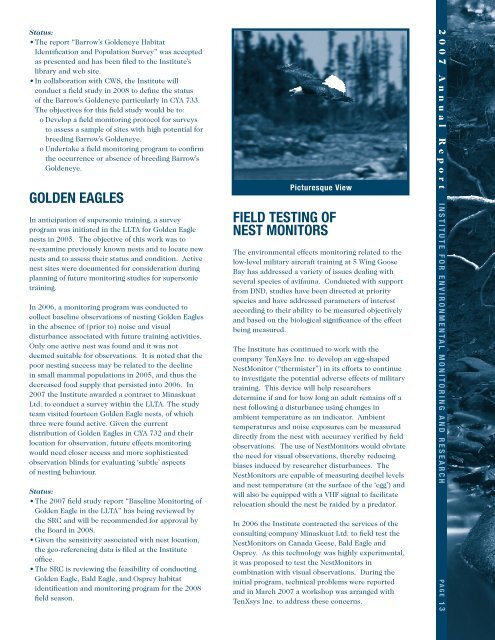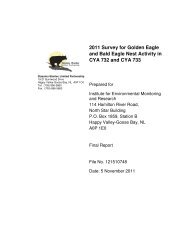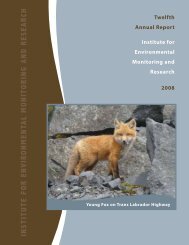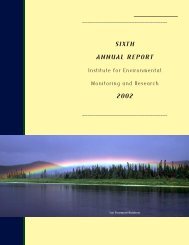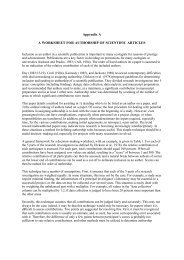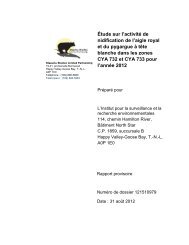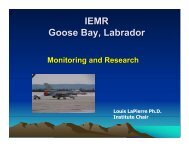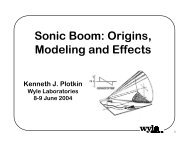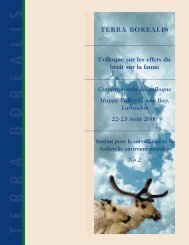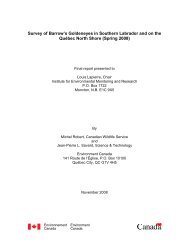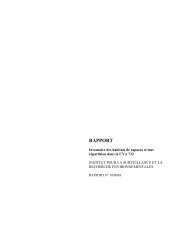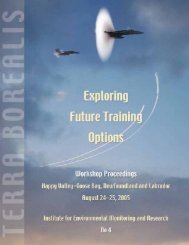2007 Annual Report - Institute for Environmental Monitoring and ...
2007 Annual Report - Institute for Environmental Monitoring and ...
2007 Annual Report - Institute for Environmental Monitoring and ...
- No tags were found...
You also want an ePaper? Increase the reach of your titles
YUMPU automatically turns print PDFs into web optimized ePapers that Google loves.
Status:• The report “Barrow’s Goldeneye HabitatIdentification <strong>and</strong> Population Survey” was acceptedas presented <strong>and</strong> has been filed to the <strong>Institute</strong>’slibrary <strong>and</strong> web site.• In collaboration with CWS, the <strong>Institute</strong> willconduct a field study in 2008 to define the statusof the Barrow’s Goldeneye particularly in CYA 733.The objectives <strong>for</strong> this field study would be to:o Develop a field monitoring protocol <strong>for</strong> surveysto assess a sample of sites with high potential <strong>for</strong>breeding Barrow’s Goldeneye.o Undertake a field monitoring program to confirmthe occurrence or absence of breeding Barrow’sGoldeneye.GOLDEN EAGLESIn anticipation of supersonic training, a surveyprogram was initiated in the LLTA <strong>for</strong> Golden Eaglenests in 2005. The objective of this work was tore-examine previously known nests <strong>and</strong> to locate newnests <strong>and</strong> to assess their status <strong>and</strong> condition. Activenest sites were documented <strong>for</strong> consideration duringplanning of future monitoring studies <strong>for</strong> supersonictraining.In 2006, a monitoring program was conducted tocollect baseline observations of nesting Golden Eaglesin the absence of (prior to) noise <strong>and</strong> visualdisturbance associated with future training activities.Only one active nest was found <strong>and</strong> it was notdeemed suitable <strong>for</strong> observations. It is noted that thepoor nesting success may be related to the declinein small mammal populations in 2005, <strong>and</strong> thus thedecreased food supply that persisted into 2006. In<strong>2007</strong> the <strong>Institute</strong> awarded a contract to MinaskuatLtd. to conduct a survey within the LLTA. The studyteam visited fourteen Golden Eagle nests, of whichthree were found active. Given the currentdistribution of Golden Eagles in CYA 732 <strong>and</strong> theirlocation <strong>for</strong> observation, future effects monitoringwould need closer access <strong>and</strong> more sophisticatedobservation blinds <strong>for</strong> evaluating ‘subtle’ aspectsof nesting behaviour.Status:• The <strong>2007</strong> field study report “Baseline <strong>Monitoring</strong> ofGolden Eagle in the LLTA” has being reviewed bythe SRC <strong>and</strong> will be recommended <strong>for</strong> approval bythe Board in 2008.• Given the sensitivity associated with nest location,the geo-referencing data is filed at the <strong>Institute</strong>office.• The SRC is reviewing the feasibility of conductingGolden Eagle, Bald Eagle, <strong>and</strong> Osprey habitatidentification <strong>and</strong> monitoring program <strong>for</strong> the 2008field season.Picturesque ViewFIELD TESTING OFNEST MONITORSThe environmental effects monitoring related to thelow-level military aircraft training at 5 Wing GooseBay has addressed a variety of issues dealing withseveral species of avifauna. Conducted with supportfrom DND, studies have been directed at priorityspecies <strong>and</strong> have addressed parameters of interestaccording to their ability to be measured objectively<strong>and</strong> based on the biological significance of the effectbeing measured.The <strong>Institute</strong> has continued to work with thecompany TenXsys Inc. to develop an egg-shapedNestMonitor (“thermister”) in its ef<strong>for</strong>ts to continueto investigate the potential adverse effects of militarytraining. This device will help researchersdetermine if <strong>and</strong> <strong>for</strong> how long an adult remains off anest following a disturbance using changes inambient temperature as an indicator. Ambienttemperatures <strong>and</strong> noise exposures can be measureddirectly from the nest with accuracy verified by fieldobservations. The use of NestMonitors would obviatethe need <strong>for</strong> visual observations, thereby reducingbiases induced by researcher disturbances. TheNestMonitors are capable of measuring decibel levels<strong>and</strong> nest temperature (at the surface of the ‘egg’) <strong>and</strong>will also be equipped with a VHF signal to facilitaterelocation should the nest be raided by a predator.In 2006 the <strong>Institute</strong> contracted the services of theconsulting company Minaskuat Ltd. to field test theNestMonitors on Canada Geese, Bald Eagle <strong>and</strong>Osprey. As this technology was highly experimental,it was proposed to test the NestMonitors incombination with visual observations. During theinitial program, technical problems were reported<strong>and</strong> in March <strong>2007</strong> a workshop was arranged withTenXsys Inc. to address these concerns.2 0 0 7 A n n u a l R e p o r t I n s t i t u t e f o r E n v i r o n m e n t a l M o n i t o r i n g a n d R e s e a r c h P a g e 1 3


